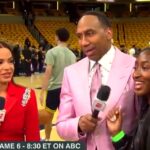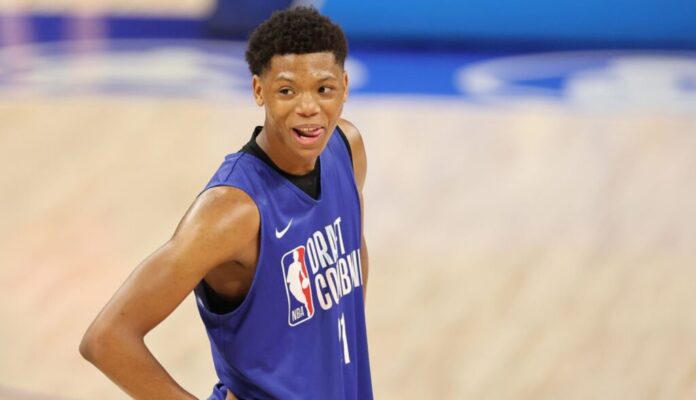
As the 2025 NBA Draft approaches, one name that continues to generate buzz—for all the right and wrong reasons—is Ace Bailey. The hyper-athletic wing from Rutgers has long been viewed as a potential top-five pick, but in recent weeks, Bailey’s approach to the pre-draft process has raised eyebrows around the league. Most notably, Bailey reportedly declined to meet with any NBA team for individual workouts, including canceling a scheduled dinner with the Philadelphia 76ers, who own the No. 3 pick.
While some see this as a calculated power move, others are beginning to wonder if Bailey’s strategy might backfire. Is Ace Bailey NBA Draft Stock falling? Is his demand for a starting role a sign of supreme confidence, or an ill-advised gamble that could send him tumbling down draft boards?
Setting the Scene: The Refusals That Shook the Draft Process
In a pre-draft landscape filled with handshakes, workouts, and Zoom interviews, Ace Bailey has chosen silence. His camp has been tight-lipped. He hasn’t granted private meetings, conducted team interviews, or even attended key pro days. The cancellation of a dinner with the Philadelphia 76ers—a team actively seeking a young wing to plug into their playoff-caliber rotation—sparked a new wave of intrigue. The message was clear: Ace Bailey is not going to chase the draft process. He expects teams to come to him.
In a league where optics matter almost as much as performance, Bailey’s approach is nearly unprecedented in recent memory. Even consensus No. 1 picks typically meet with teams out of courtesy or curiosity. But Bailey appears focused on one thing—immediate opportunity. He wants a starting role from Day 1. No G League. No development years. No bench rotation purgatory. Just minutes, a green light, and a franchise willing to hand him the keys.
Confidence or Arrogance? The Double-Edged Sword
There’s no denying Ace Bailey’s talent. He’s a 6’8″ wing with a 7’1″ wingspan, elite quickness, and above-the-rim athleticism that pops off the screen. He’s shown flashes of three-level scoring, positional defense, and a competitive fire that scouts love. Physically, he checks every box for a modern NBA wing. But talent alone doesn’t guarantee a starting role. And in the eyes of some general managers, Bailey’s refusal to engage in the traditional pre-draft courtship is more than just a red flag—it’s a billboard.
For teams outside the top three, Bailey’s strategy introduces risk. Why invest in a player who won’t meet with your front office or coaching staff? What if he doesn’t want to play for your city? What if he refuses to come off the bench or accept a role in your developmental plan? These are not small concerns. For every confident young star who demanded early responsibility and thrived (think Anthony Edwards or LaMelo Ball), there are just as many who flamed out under the weight of their own expectations.
Why the 76ers Were a Critical Missed Opportunity
The Philadelphia 76ers, holding the No. 3 overall pick, are at a crossroads. With Joel Embiid still in his prime and Tyrese Maxey emerging as a star, the franchise is seeking a third cornerstone to complete their core. Bailey would have made an intriguing fit—an athletic wing who could guard multiple positions, run in transition, and grow alongside Philly’s established stars. Canceling the dinner with them sent a message: Bailey may not be interested in playing third fiddle to anyone.
Some analysts believe this specific refusal could cost Bailey dearly. The Sixers are not just a team with a high pick—they’re a team with a win-now mindset. They want players who want to win. By declining to even sit down with them, Bailey may have signaled a lack of buy-in, maturity, or willingness to be coached. Whether that’s fair or not, perception shapes reality on draft night.
How NBA Teams Might Interpret Bailey’s Demands
So what exactly is Bailey’s endgame? Insiders suggest his team is pushing for a franchise where he can start immediately. The logic: if you draft him high, don’t bury him on the bench. Let him learn through reps, mistakes, and real-time development. It’s a philosophy that has worked for players like Scottie Barnes and Jalen Green, but only in the right environments.
However, NBA executives might read between the lines differently. To some, Bailey’s demands suggest:
- Lack of humility: A player who hasn’t played an NBA minute dictating terms is a risky proposition.
- Poor advice from his camp: Navigating the NBA requires collaboration. Refusing meetings can alienate organizations and limit future opportunities.
- Impatience: NBA teams value players who embrace development. Demanding to skip steps can be seen as entitlement.
The Case for Bailey Holding His Ground
On the other side of the debate, many are applauding Bailey’s assertiveness. This is a player who knows what he wants. In an era where athletes are reclaiming agency, Bailey’s strategy may simply be ahead of its time. Why waste energy on interviews with teams that won’t use him properly? Why say yes to a franchise that doesn’t offer a clear vision or fit? After all, if he’s a top-five talent, he should be treated like one.
Some GMs may even be drawn to this type of confidence. Star players often carry an edge, and the willingness to bet on oneself is part of what separates All-Stars from role players. If a team believes in Bailey’s work ethic, skill set, and ceiling, they may ignore the noise and make the pick anyway—especially if they believe they can coach him into maturity.
Draft Stock Watch: Rise, Fall, or Stay the Same?
As of now, Bailey remains in the conversation for picks 3 through 8. Teams like the Hornets, Trail Blazers, Spurs, and Wizards could all use a player of his profile. But the big question is whether the teams in that range are willing to gamble on potential without the safety net of a pre-draft meeting. In past years, similar situations have caused players to slip. Michael Porter Jr., for instance, had injury questions and refused workouts—and fell to 14. Josh Jackson famously skipped a Celtics workout—and missed out on the third pick. History says that teams do care.
However, the talent always wins out. If Bailey has truly convinced teams that he’s the best athlete in the draft, his stock may hold steady. The lack of meetings might narrow his suitors, but it only takes one to buy in. And sometimes, all you need is the right fit—not the right process.
The Best-Case Scenario
The ideal situation for Bailey is a franchise with a strong developmental culture, a patient coaching staff, and a roster hole on the wing. A team like San Antonio, where a player can grow under a legendary coach without being thrown into chaos, might be perfect. Charlotte and Washington offer starting opportunities, but perhaps not the structure. If Bailey lands in the right system, with room to play and grow, his bet on himself might pay off handsomely.
The Worst-Case Scenario
The nightmare outcome? A fall into the late lottery or mid-first round, where minutes are harder to come by and patience wears thin. If he’s labeled difficult before he even debuts, he may spend the early part of his career fighting perception as much as defenders. And if he struggles early without the support of a system built around him, the pressure could snowball.
Final Thoughts: High Risk, High Reward
Ace Bailey is a fascinating case study in the evolving dynamics of the NBA draft. He’s not just auditioning for the league—he’s flipping the script, asking teams to audition for him. Whether this turns out to be a trailblazing move or a misstep remains to be seen. But one thing’s for certain: Bailey isn’t afraid to bet on himself.
The 2025 NBA Draft will answer the questions everyone’s asking. Will his refusal to meet with teams cost him millions? Will his demand for a starting role scare off contenders? Or will a smart front office see past the optics and take the leap?
All it takes is one believer. And if Bailey’s talent meets the right opportunity, he might look back on this pre-draft drama as the moment he set his own course—and won.
Don’t forget to monitor THD’s 2025 NBA Mock Draft Database to stay up to date on where the experts think teams will go with their draft picks.


















